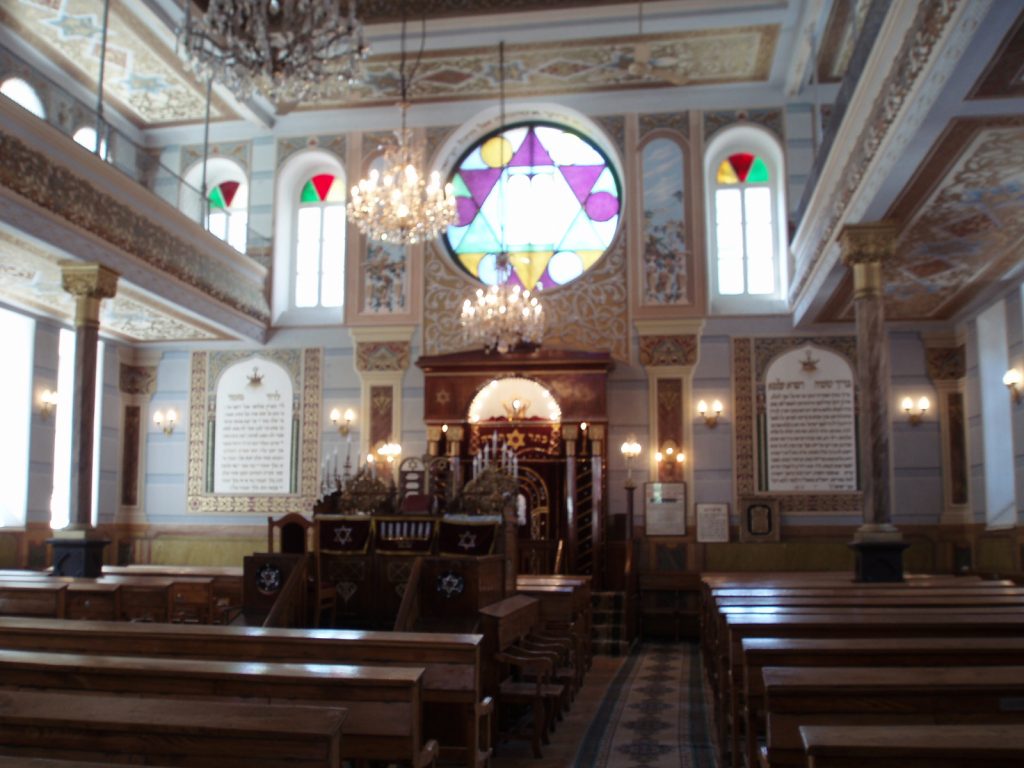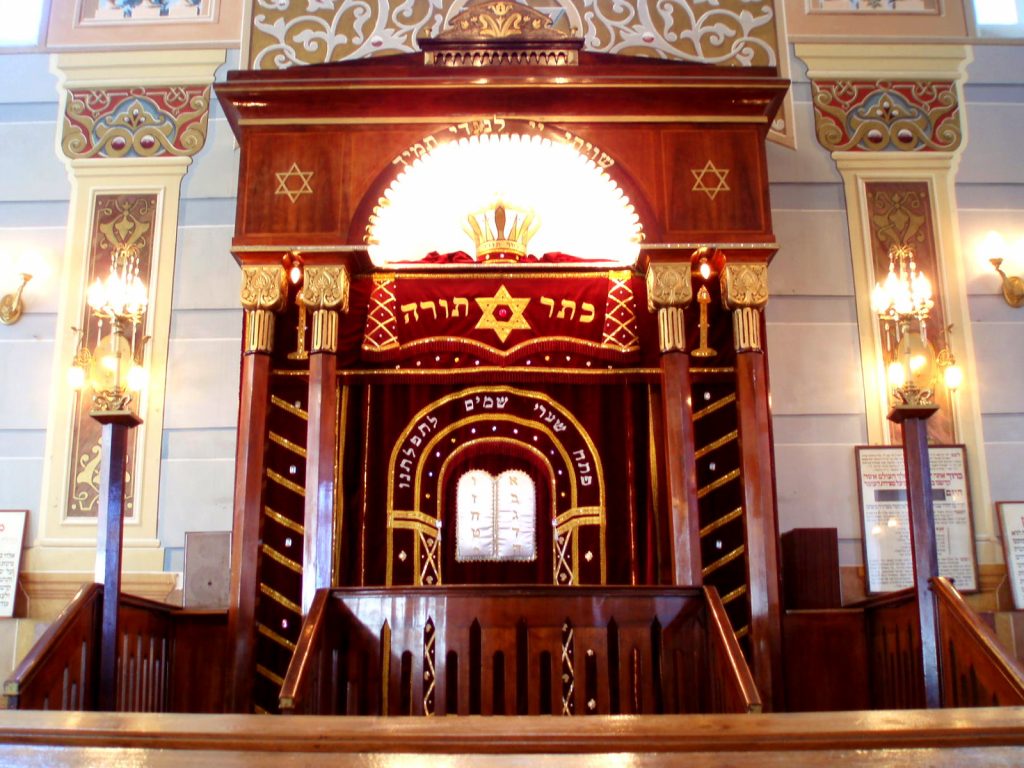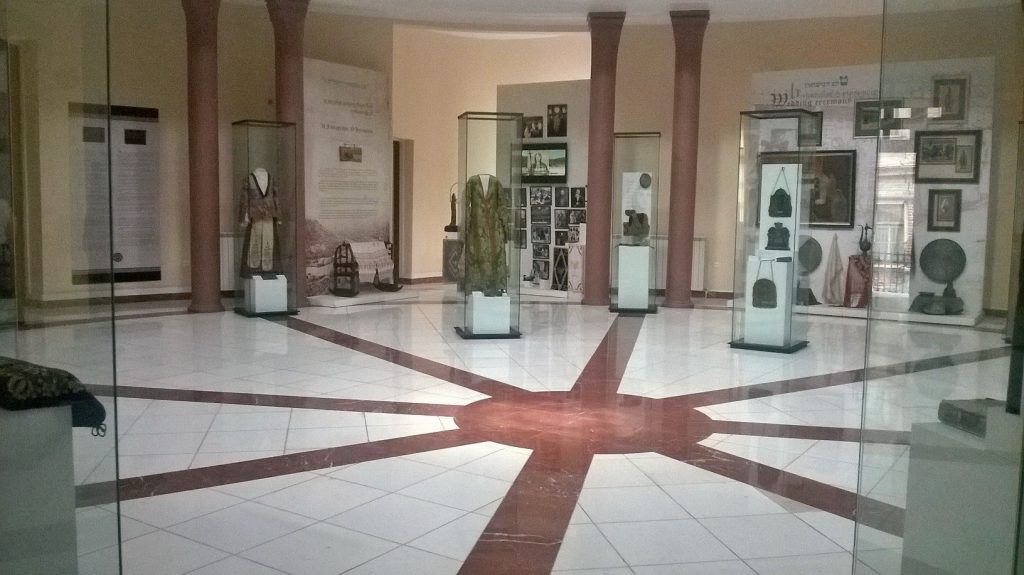
Most of the Jewish sites in beautiful Tbilisi are concentrated in the old city, in the neighborhoods along the left bank of the Kura River. Starting from the Vakhtang Gogasali Square (Meidan Square), located near the traditional Persian baths, take the main street of the old town, Kote Afkhazi Street, which you will go up a hundred meters to see on your left the Great Synagogue of Tbilisi.

Built at the beginning of the twentieth century in the area of the old Armenian bazaar by worshipers from Akhaltsikhe, in southern Georgia, hence the synagogue name Akhaltsikhe sometimes used to designate, the great synagogue of Tbilisi is an imposing brick building of Moorish inspiration, with interior facades decorated with beautiful newly renovated gold and blue frescoes.
If you are in Tbilisi during Shabbat or during a Jewish holiday, be sure to attend the services of the Great Synagogue, conducted according to the Georgian Jewish rite and usually welcoming a large number of faithful. Make the most of your visit to the synagogue and grab a meal at David restaurant, adjacent to the latter and in which you can enjoy, in the strictest rules of kashrut, delicious Georgian dishes such as khinkali, a kind of big stuffed ravioli, or the katachpuri, a big bread loaf.
Close to the Great Synagogue, at 2/5 Jerusalem Street, is another kosher restaurant, the Jerusalem restaurant, opened by Georgian Jews who returned from Israel in the 2000s.

Going back to Kote Afhazi Street, which continues along Leselidze street, you will see at number 28 of this street the Tbilissi synagogue, the so-called Ashkenazi synagogue, located in a courtyard made up of a group of traditional houses, and indicated by a sign in Hebrew in the street. Originally built in the early twentieth century for the Ashkenazi Jewish community of Georgia, this synagogue, also named Beit Rachel, was rebuilt in 2009, the original building being heavily damaged in the aftermath of the 1991’s earthquake. Shabbat and feasts are regularly held in this synagogue, run by the Habad movement. If you are in Tbilisi during Shabbat, you can also spend dinner in this community: it is always a very welcoming experience. The small synagogue of Tbilisi also has a Beit Habad.
Walk up Kote Afkhazi Street until you reach the intersection with Anton Katalikosi Street, which you will take until number 3, where the Jewish Museum of Tbilisi is located. Named in honor of David Baazov, a Georgian rabbi who played a significant role in the development of the local Zionist movement, the Jewish Museum of Tbilisi was inaugurated in 1932, then closed in 1951, in a context marked by a surge of anti-Semitism. This was indeed the time of the struggle against “cosmopolitanism” and the so-called “white coats conspiracy”. Its doors were reopened in 1992, after independence, and it is now housed in a beautiful brick building built in the early twentieth century and previously used as a synagogue.

Of modest size, the Jewish Museum of Tbilisi houses a number of objects of daily life and religious Georgian Jews and offers a valuable panorama of this community to history often unknown. You can also admire the paintings of Shalom Koboshvili (1876-1941) and David Gvelesiani (1890-1949), two famous Georgian painters of Jewish faith. In addition, the David Baazov Museum regularly hosts temporary exhibitions, usually dedicated to the history of Jewish communities in Europe.
The National Museum of Georgia, located not far from Freedom Square on Shota Rustaveli Avenue, also has a substantial Jewish fund, which in recent years has been the subject of an admirable work of valorization. You can prepare your visit by consulting the website Jewish Cultural Heritage, which exhaustively lists all the particularly rich collection of Jewish history and art of the museum.

Finally, you can also admire at the Institute of Manuscripts of Georgia, located a little further north of the city near the Technical University subway station, a splendid Torah dating from the 10th century, discovered in the 1940s in the region of Svaneti, in the village of Lailashi.
You can finish your tour in Jewish Tbilisi by visiting Jewish cemeteries on the outskirts of the city. There are three. The one traditionally reserved for the Ashkenazi community is in the village of Navtlugi. The village of Ortchala is home to another Jewish cemetery. These two cemeteries are no longer active but are maintained by the community, which continues to bury its faithful at the cemetery of Dampalo, in the village of Varketili. As these three cemeteries are on the outskirts of Tbilisi, the taxi is still the easiest way to get there.
In recent years, and particularly since the pogrom of 7 October, Georgian cities, including Tbilisi, have seen a revival of local Jewish life, far removed from the numerous manifestations and acts of anti-Semitism present in many European cities.